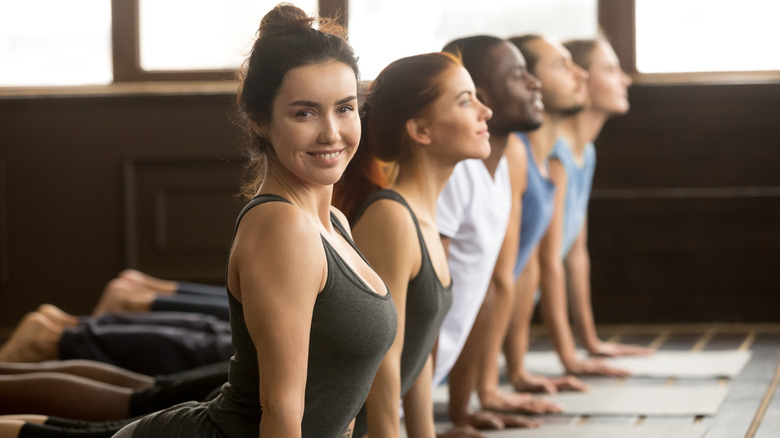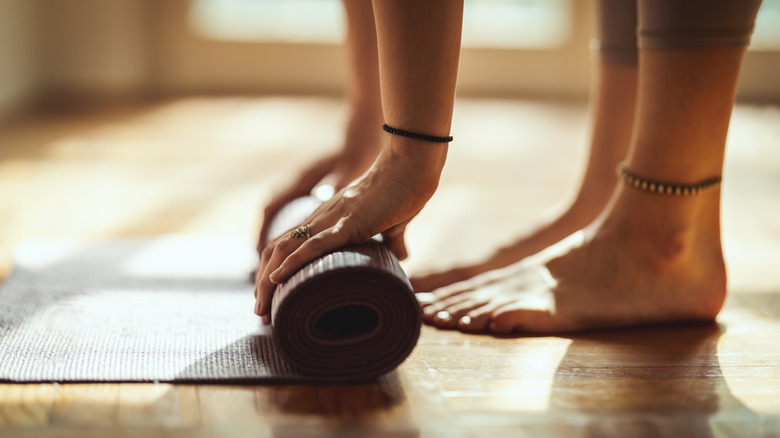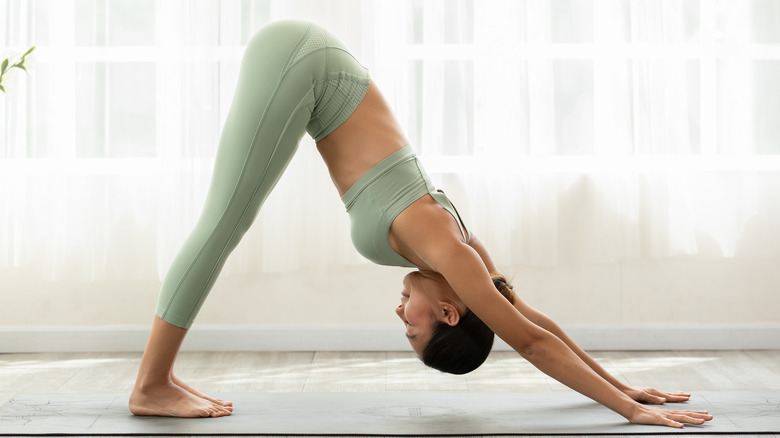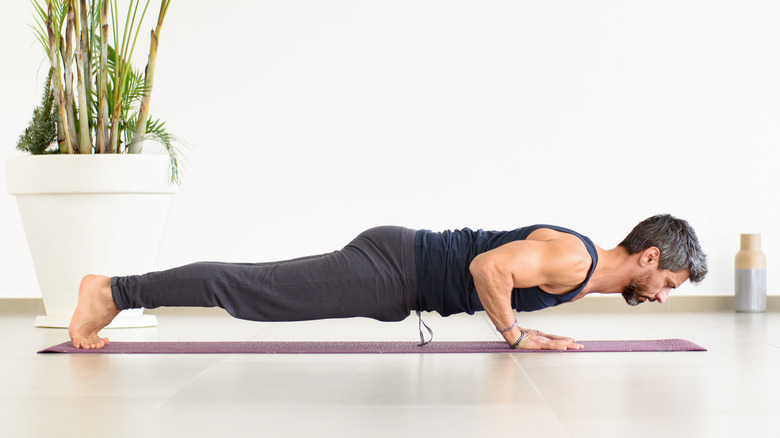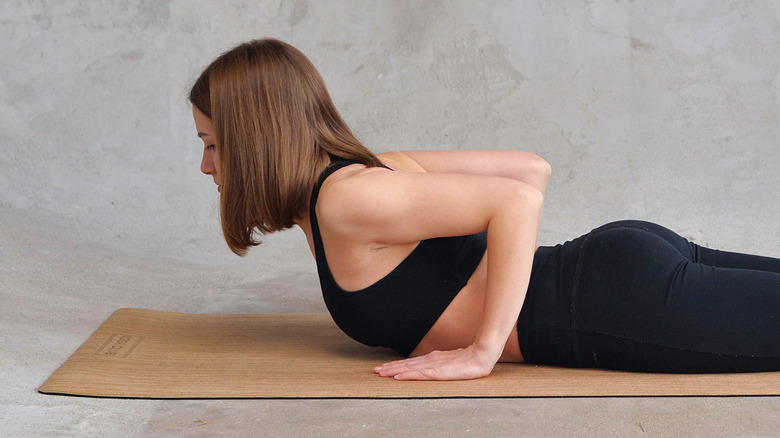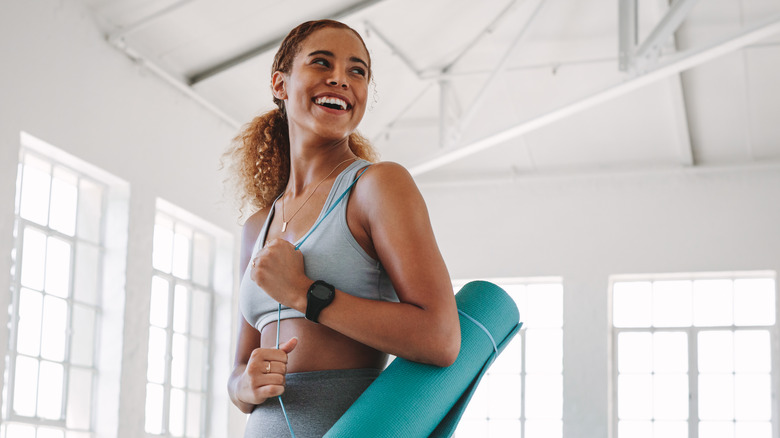Everything You Need To Know About Vinyasa Yoga
If you've ever watched any yoga-related reels on Instagram, more than likely you've seen a vinyasa yoga sequence. The yogi will flow from one pose to the next, holding some poses for longer. This flow is key to vinyasa, and it somewhat sets it apart from other styles such as hatha or yin yoga.
In Sanskrit, vinyasa means to place (nyasa) in a special way (vi), according to Yoga Journal. This special way is through the breath. Therefore, vinyasa links the poses with breath. Some yoga teachers will use vinyasa sequences in styles such as power yoga or Ashtanga yoga. They might create a unique sequence of poses for branding purposes, but any style of yoga that connects breath with movement is considered vinyasa.
You might not see the word "vinyasa" in yoga class listings. Some yoga studios substitute words like "flow" to indicate a dynamic vinyasa class. Vinyasa classes tend to be much more energetic than others. Each vinyasa class will be different, and even if you take a vinyasa class from one instructor, the class might be different each week. Therefore, if you like variety, then vinyasa is a good choice.
Terms you'll hear in vinyasa class
According to yoga teacher Jason Crandell, the key foundation in any vinyasa class is the sun salutation, also called surya namaskar. Classes might warm up using them, or they might integrate versions of sun salutations into various sequences of poses. The basic sun salutation starts with standing tall and extending the arms upwards, then you hinge from the hip into a forward bend. Keeping the core engaged, you lift your torso halfway, then step back into a plank position. From there, you have the option of doing a cobra or upward-facing dog, then you finish in a downward-facing dog. To get back up, you step your feet to your hands then bring your torso back to standing. More on these poses in a bit.
Yoga instructors also use the word vinyasa to indicate a release from a difficult pose or sequence. The phrase "take a vinyasa" means to bring your body into a plank, chaturanga, cobra, then downward-facing dog. Taking a vinyasa might sound like a relief after a challenge, but it's typically used to realign or reset the body (per Do You Yoga). The short vinyasa is a challenge itself, so students are encouraged to rest in a child's pose if they are too tired.
Let's look at these poses in a little more detail.
Downward-facing dog isn't for beginners
Although downward dog might sound like a break to experienced yoga students, it's technically a more intermediate yoga pose. Because it can strain the wrists or hurt your calves, you might need to modify it until you build more strength.
Yoga teacher Leah Sugerman suggests dropping to your knees in a downward dog to reduce the load on your upper body (via YogaU Online). Otherwise, if you have a wall or blocks nearby, use them to elevate your hands so there is less weight on them. Think about how much easier it is to do a pushup on an incline rather than a decline. To help strengthen the muscles that support your wrists, a bolster forces you to use your forearms while also targeting any imbalances.
Because many new vinyasa students have tight calves and Achilles tendons, Sugerman suggests placing a folded-up blanket under your heels. This gives your legs a little more support because your heels aren't up in the air (per YogaU Online). You can also bend your knees and shorten the distance between your hands and feet.
Chaturanga can challenge your upper body
A vinyasa class will more than likely have a low plank pose, called chaturanga. According to Yoganatomy, chaturanga is a common culprit in shoulder injuries. Because most vinyasa practices will move through several chaturangas in a class, a student will suffer from an overuse injury in the shoulder rather than suddenly hurting it during a single class. During a vinyasa class, some students might jump into a chaturanga pose from a standing forward bend, which causes excess stress on the shoulder joint. If you're new to vinyasa, you might want to avoid doing this.
According to Coury & Buehler Physical Therapy, you can protect your shoulders from injury by learning how the shoulders should be aligned. While standing, roll your shoulders slightly back so they line up with your ears. Flex your wrists 90 degrees. Bend your elbows, also at 90 degrees, until they hug your ribs. Raise your forearms from your body, keeping them parallel to the floor. That's how your upper body should be in chaturanga. If this is still too much weight on your shoulders and wrists during a vinyasa class, practice chaturanga with your knees down.
Cobra or upward-facing dog?
Yoga teachers will cue cobra or upward-facing dog. What's the difference? Cobra pose keeps your pelvis on the ground, whereas upward-facing dog does not (per Yoga Alignment Guide). Both poses are backbends, so your shoulders should roll back and into their sockets. Like chaturanga, you'll also squeeze your shoulder blades together.
Cobra pose often keeps the elbows bent and facing the back of your mat. Your hands can be placed either close to your sides or further away from you, but be sure to keep them below your shoulders so they don't roll forward. You can push up slightly with your hands, but try not to bear too much weight in them. What's key is using your back muscles to bring your chest off the ground, which might be difficult the first few tries (per Yoga Journal).
Upward-facing dog employs a little more strength and flexibility, so you might want to avoid this one if you're new to vinyasa. Because your pelvis and thighs come off the floor (via Yoga Basics), you're supporting your weight with your arms and the tops of your feet.
Health benefits of vinyasa yoga
A 2018 systematic review in Complementary Therapies in Clinical Practice has found that yoga can modestly improve mental health. However, specific studies focused on the benefits of vinyasa yoga classes have found positive effects on well-being. A 2014 study had cancer patients' caregivers take vinyasa classes for six weeks. Afterwards, the caregivers lowered their stress levels and improved their quality of life.
Vinyasa can also help you quit smoking. According to a 2012 study in the Journal of Women's Health, women who took vinyasa yoga classes twice a week for eight weeks were more likely to accomplish a week without cigarettes than women who participated in a general wellness program. They also had lower levels of anxiety and a greater sense of well-being.
Research has also looked into the physiological benefits of vinyasa yoga. A 2017 study in Psychoneuroendocrinology found that yoga can keep your nervous and adrenal systems healthy. Even experienced yogis can improve their health after a single class. According to a 2021 study in Complementary Therapies in Medicine, a one-hour vinyasa class reduced unhealthy levels of cholesterol and helped ease negativity. The researchers added that vinyasa yoga helps the cardiovascular system.
However, the National Institutes of Health recommends that people who are pregnant, over the age of 65, or have health conditions consult their doctors and yoga instructors about whether they need to avoid or modify any yoga practices for their own safety. New practitioners may also want to avoid extreme practices.

